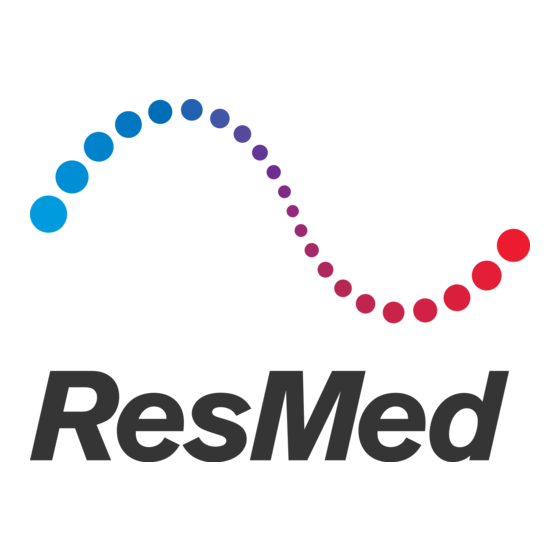

ResMed AirSense 10 Autoset Use And Care Manual
Hide thumbs
Also See for AirSense 10 Autoset:
- User manual ,
- Start manual (20 pages) ,
- Quick start manual (4 pages)
Table of Contents
Advertisement
Quick Links
Introduction
This instruction manual explains use and maintenance of an AirSense 10 AutoSet machine.
This is an auto-adjusting positive airway pressure (aCPAP) device that can be used to treat
obstructive sleep apnea (OSA).
Components
AirSense 10 aCPAP
Integrated humidifier water tub
ClimateLine Air tubing
Filters
Power supply and power cord
SD Card
Masks based upon mask fit, size, and comfort
Sleep SMART Care Team Phone Number
470-655-6688
1
Advertisement
Table of Contents

Summary of Contents for ResMed AirSense 10 Autoset
- Page 1 Introduction This instruction manual explains use and maintenance of an AirSense 10 AutoSet machine. This is an auto-adjusting positive airway pressure (aCPAP) device that can be used to treat obstructive sleep apnea (OSA). Components AirSense 10 aCPAP Integrated humidifier water tub...
- Page 2 Use and Care of The PAP Device...
- Page 4 Setting Up The PAP Unit...
-
Page 5: Filling The Water Tub
Filling the Water Tub... - Page 6 Setting Up the ClimateLine Air Tubing 1. Align the ClimateLine Air tubing with the ClimateLine Air connection port. Push the ClimateLine tubing firmly onto the air outlet. 2. Connect the assembled mask system to the free end of the ClimateLine air tubing. Adjusting to Therapy If the subjects are first-time users, they might need some time to get used to the therapy.
-
Page 7: Climate Control
● Trouble falling asleep - If they have having trouble falling asleep with high pressure, turn on Auto Ramp or increase Ramp Time. ● Bloated feeling - If they are experiencing a slightly bloated feeling from swallowing air, turn on Auto Ramp or increase Ramp Time ●... -
Page 8: Getting Started
Getting Started 1. Make sure the power is connected. 2. Adjust the humidification level, if required. 3. Fit the mask as described in the mask user guide. 4. To start therapy, press the Start/Stop button or simply breathe into the mask. The Smart Start function will turn on the device. - Page 9 When They Wake Up ● Turn off the aCPAP unit by pushing the Start/Stop button on the device or by simply removing the mask. This will also turn off the humidifier. ● Disconnect the hose and take the water out. Be careful with the humidifier because the heating element may be hot.
- Page 10 ● The subject can always use the Start/Stop button on the top of the aCPAP. As the SmartStart feature will generally be enabled, the device will start automatically when the subject breathes into the mask. ● Never turn the device on until the mask is on the subject’s face. ●...
- Page 11 when occasionally necessary. Encourage subjects to call the Sleep SMART Care Team for filters, hoses, and replacement cushions or pillows when needed. 5. Proper Cleaning Techniques It is recommended that the water chamber, mask cushion, and nasal pillows be cleaned daily. All other items should be cleaned weekly or more often including the hose.
-
Page 12: Troubleshooting
Troubleshooting Issue Possible Solution Frequent Awakenings Try to determine cause, and respond as listed below if any of these more specific problems are identified. Contact Sleep SMART Care Team. Air leak from mask seal with nose or face Tighten headgear that holds mask, within tolerated range; change from nasal pillows or full face mask (which tend to leak more especially with high pressures) to nasal triangle mask. - Page 13 Frequently Asked Questions by PAP Patients Q: Why is air still blowing from the Automatic Positive Airway Pressure (aCPAP) machine after I turn it off? A: The aCPAP machine will blow a small stream of air to cool the heating element. The aCPAP machine will turn itself off after 20 minutes.
- Page 14 get used to aCPAP. Using water-soluble gel or spray may help for some people. If the discomfort continues, contact the Care Team. You may need a different mask. S leep SMART Q: I don’t think the humidifier is heating the water in the tub. What should I do? A: Check the humidifier to make sure it is properly attached to the aCPAP device.
- Page 15 Appendix SD Card An SD memory card has been supplied to gather therapy data from the AirSense 10 device. Subjects should only remove the SD card when instructed to do so. They should disconnect the AirSense 10 device from the power outlet, remove the SD card, insert it in the protective folder and send it to FusionHealth.
- Page 16 Disassembling the Water Tub Reassembling and Filling the Water Tub 1. Place the tub lid back onto the base. 2. Clip all for side latches. 3. Fill the water tub with distilled or water up to the maximum water level mark. 4.
-
Page 17: Glossary Of Terms
Glossary of Terms Apnea - literally means “no breath”; the pausing of airflow at the nostrils and mouth for a least 10 seconds. Apnea Index (AI) - total number of apnea events per hour. Apnea-Hypopnea Index (AHI) - the number of apneas and hypopneas per hour of sleep, used more loosely in Sleep SMART to refer to the number of apneas and hypopneas per hour of recording by the Nox T3 sleep apnea testing device, which records breathing, but not sleep. - Page 18 Obstructive Hypopnea — an episode of partial closure of the airway during sleep, for at least 10 seconds resulting in reduced air exchange, blood oxygen drops, and/or brain arousals. Polysomnogram — often called a “sleep study,” this test is attended by a technologist, in a sleep laboratory.













